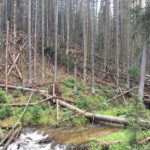Trees Are Killing Forests
Posted: November 14, 2016Source: The Forest Blog by Russ Vaagen

I hear people say and read all the time that the following things have got us into this situation:
- Fire suppression activities over the last 100 years
- Climate change, more specifically a warming climate with longer fire seasons
- Past management practices
I totally agree with the first two. We have put out fires very aggressively, end in areas where we should have allowed it to act naturally. In the lowland areas around homes, private property, other landowners, and where we have valuable forests should be protected and aggressively suppressed. It’s the areas in the backcountry that should be watched and monitored and only attacked when they threaten those other resources.
Climate change is a reasonable reason as to why we are seeing more fires in our forests. Especially when you consider that so much of our publicly owned forests have been sparsely managed over the last 25 years.
During that time the fuels in the form of small trees and brush have grown to levels that we’ve never seen before. This is where the trees are really killing the forest. When fuels like that are mixed with longer, hotter summers with dry lighting we will get massive fires. It does beg the question if we have the cart before the horse on this one. Maybe the forests are contributing to climate change and a warming climate? More trees, consuming more water, becoming massive fuel loads until they create immense CO2 pollution during fires. Then those lands are removed from the large scale photosynthesis that cleans our air for many years. None of that is very good.
The third bullet I have issue with. I am not going to say that all forest practices were perfect. Some, in fact, were bad. Does this mean that “past management practices” rises to the level of the first two as a cause of this forest health and wildfire crisis. There’s a couple of thoughts I have on this. The first is that lands that have continually been managed over the last 25 year have seen much less fire in the same areas where National Forest lands have burned up at catastrophic levels. I’m not suggesting fires don’t start and burn there, but many times they behave much differently and even sometimes beneficially. The second question I have on this is if we have basically been managing from a restoration perspective for the last 15 to 20 years with great results, why are management practices in our forest 30-40 years ago being brought up as part of the main cause of our current fire danger?
I think it’s become a obligatory talking point that needs to be removed. I think some have been saying it for so long they just think it needs to be said. I think people need to examine this. I think it cause real damage to what collaborative groups have been working on for the last 15 years. When “past management practices” or “past logging practices” are cited as a reason for our current fire predicament how is the public, especially the urban public, supposed to know what that means? Does it mean the thinning that we’ve been doing most of the last two decades? Does it mean some of the skips and gaps practices have only recently been put into practice? I know it’s supposed to mean the past practice of “high-grade logging” where only the big trees were cut and everything else was run over and slash was everywhere.
Even that doesn’t pass the smell test for me anymore and here’s why. This year I turn 40 years old. I don’t ever recall seeing something like that in my life. This is coming from someone who’s spent a great deal of time in the forest. Have I seen bad logging practices? You bet I have, but they don’t look like what is being described. I do not like large clear-cuts, especially in inland forests where it takes so long for the forests to grow back. I think it’s very damaging socially to clear-cut and then apply herbicides. That’s not the way our family has decided to manage our forest lands. All those things being said, I find it hard to blame even the poorest logging jobs that I’ve seen as a cause of forest fires.
The only way I think it’s fair to say that past management practices are a leading cause of massive wildfires is to then also include environmental pressures and lawsuits. Of which I think would be a mistake. I know people in the conservation community that I work with that would be very upset at hearing that included, and for good reason. Many of them have been working hard on new solutions to fix this problem. I only share this because it hurts those of us that still remain in this industry that we won’t let that meaningless talking point go. The third point could be any number of issues from lack of small diameter, rural mills or poor congressional leadership to address the epidemic, or rudderless management from the Forest Service for 25 years. Even those aren’t as important as rolling up our sleeves and working to solve these very real issues.
As for the issue of “past management practices” being one of the main causes for our current fire situation I would just say this, that horse is dead. It’s been dead for a long time. Continuing to kick it just upsets those looking on.
